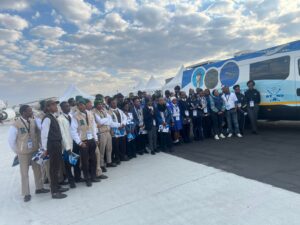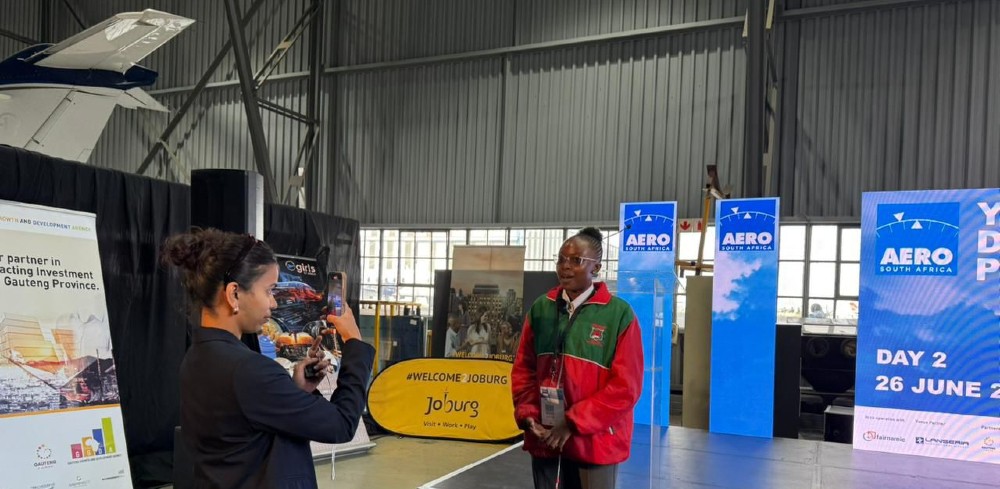
On 26 July, Girls Fly Africa (GFA) participated in a Youth Development Programme, hosted on the sidelines of Aero South Africa. The event was hosted at Lanseria International Airport, just north of Johannesburg. The engaging programme provided an opportunity for South Africa’s youth to learn about the aviation industry and to gather information about careers in the sector.
The programme kicked off with some ice-breaker activities, where the students from over 60 high schools across Gauteng formed teams and participated in a tower-building challenge. The goal was to create a tower that would not collapse.
This activity taught the students valuable skills, including collaboration, communication, problem-solving, as well as critical and creative thinking.
After this, the students heard from experts in the aviation sector. Topics included Air Traffic Management (ATM), the procurement of aircraft and parts, as well as reflections on working as a commercial pilot. These insightful presentations informed the students about aviation.
The programme then focused on the aviation industry as a space for employment. The students were introduced to the range of opportunities available in this sector, including aircraft design, air traffic control, pilot, cabin crew, maintenance technicians, airport staff, aviation medicine, and training. Students, therefore, came to realise that aviation encompasses a range of diverse opportunities.
There were insightful presentations by pilots, flight instructors, cabin crew members, aeronautical engineers, and air traffic controllers (ATC), among others.Pathways to entering the aviation sector were also discussed. From bursaries to learnerships and apprenticeships, students were informed about ways to carve out careers in the sector, while being reminded of the entry requirements for this highly competitive industry. The students had an opportunity to visit various exhibition stands.
Aviation professionals and experts also discussed the role of artificial intelligence (AI) in the industry. It is clear that AI could be used to support the sector, in aspects such as weather forecasting, aircraft service scheduling and other similar tasks. In fact, AI can make life easier in many ways, but it is unlikely to replace certain key roles.
To conclude, the students participated in a paper plane challenge, where they had to design and produce their own paper planes, thus putting their design skills and knowledge of aerodynamics to the test. The planes that flew the furthest competed in a final round, with the winning student receiving a prize, as well as a moment to share the design principles used in creating their paper plane. The day ended in celebration, with all students receiving certificates of participation as well as GFA goodie bags.
On 26 July, Girls Fly Africa (GFA) participated in a Youth Development Programme, hosted on the sidelines of Aero South Africa. The event was hosted at Lanseria International Airport, just north of Johannesburg. The engaging programme provided an opportunity for South Africa’s youth to learn about the aviation industry and to gather information about careers in the sector.
The programme kicked off with some ice-breaker activities, where the students from over 60 high schools across Gauteng formed teams and participated in a tower-building challenge. The goal was to create a tower that would not collapse. This activity taught the students valuable skills, including collaboration, communication, problem-solving, as well as critical and creative thinking. After this, the students heard from experts in the aviation sector. Topics included Air Traffic Management (ATM), the procurement of aircraft and parts, as well as reflections on working as a commercial pilot. These insightful presentations informed the students about aviation.
The programme then focused on the aviation industry as a space for employment. The students were introduced to the range of opportunities available in this sector, including aircraft design, air traffic control, pilot, cabin crew, maintenance technicians, airport staff, aviation medicine, and training. Students, therefore, came to realise that aviation encompasses a range of diverse opportunities.
There were insightful presentations by pilots, flight instructors, cabin crew members, aeronautical engineers, and air traffic controllers (ATC), among others.Pathways to entering the aviation sector were also discussed. From bursaries to learnerships and apprenticeships, students were informed about ways to carve out careers in the sector, while being reminded of the entry requirements for this highly competitive industry. The students had an opportunity to visit various exhibition stands.
Aviation professionals and experts also discussed the role of artificial intelligence (AI) in the industry. It is clear that AI could be used to support the sector, in aspects such as weather forecasting, aircraft service scheduling and other similar tasks. In fact, AI can make life easier in many ways, but it is unlikely to replace certain key roles.
To conclude, the students participated in a paper plane challenge, where they had to design and produce their own paper planes, thus putting their design skills and knowledge of aerodynamics to the test. The planes that flew the furthest competed in a final round, with the winning student receiving a prize, as well as a moment to share the design principles used in creating their paper plane. The day ended in celebration, with all students receiving certificates of participation as well as GFA goodie bags.





